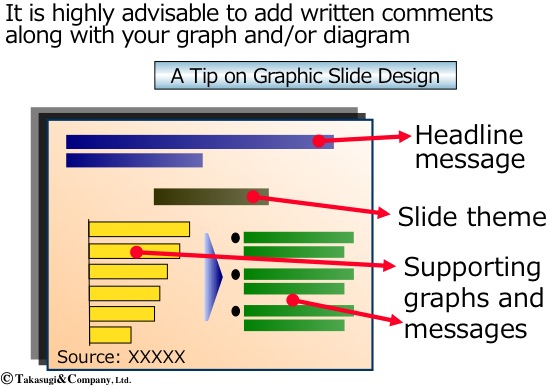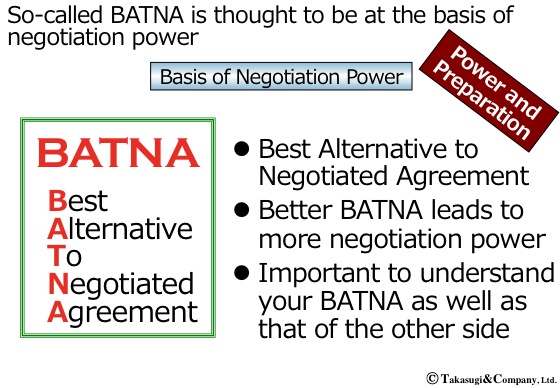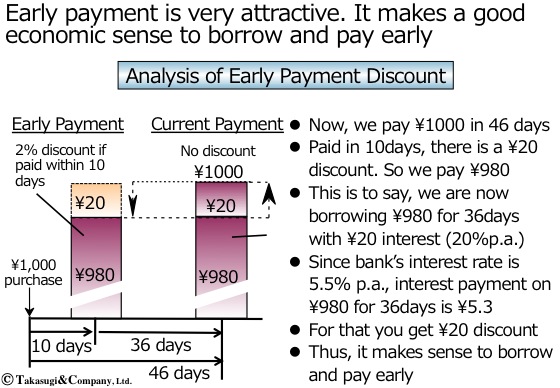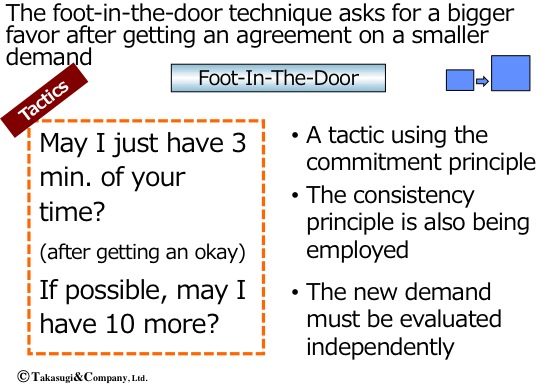
前回に引き続き、スライド説明手順を解説します。
今回は、特に、グラフや図解を含んだスライドを取り上げます。
(最後に動画解説を掲載)
グラフや図解を含んだスライドの基本構造は、前回の、文字(テキスト)ベースのスライドと同じです。
少しおさらいしておきましょう。
(前回のテキストスライドの説明手順はこちら)
スライドには3つの情報を織り込みます。
一番上に、忘れずに、最も伝えたいメッセージである「見出しメッセージ」を入れます。
その下に、スライドの「テーマ」を入れます。
そして、中味である、「サポート」が来ます。
今回はこのサポートがテキストではなく、グラフ、表、図などになります。
グラフや図解を含むスライドの説明の仕方
それでは、説明の仕方を具体的に解説します。
説明の手順も、テキストスライドと基本的に同じです。
- まず始めに、テーマを伝えます。
- 次に、見出しメッセージを伝えます。
- そして、見出しメッセージを中味でサポートします。
- そして、最後にもう一度、見出しメッセージを確認します。
グラフや図解を含んだスライド作る場合、「文字情報」を加えることを強くお薦めします。
そうすると、効率よく説明できるようになります。
その際、図表(グラフ)の方を左側に持ってきます。
まず、視覚的にイメージを持ってもらった上で、右側で文字での説明をします。
それでは、サンプルスライドを使って実際にやってみましょう。
サンプルスライドでの説明の例1
まずは、交渉力に関連したスライドの例です。
I’d like to turn now to a basis of negotiation power.
Now, so-called BATNA is thought to be at the basis of negotiation power.
It is an acronym. What does BATNA stand for?
It stands for,
- ・Best Alternative to Negotiated Agreement
And,
- ・Better BATNA leads to more negotiation power
So, it is quite
- ・Important to understand your own BATNA as well as that of the other side…
Let’s take a look at some examples, now…
サンプルスライドでの説明の例2
次は、買掛金を早く支払うと、値引きをしてくれるというスキームの評価をしたスライドです。
Here is an analysis of the early payment discount proposal that our supplier presented to us.
Our conclusion is that,
Early payment is very attractive. It makes a good economic sense to borrow money and pay early
Let me explain why,
- ・For every purchase of, say, ¥1000 worth of merchandise, we currently pay the whole ¥1000 in 46 days
- ・The proposal is that if paid in 10 days, there would be a ¥20 discount. So we pay ¥980 in 10 days
In light of this new scheme, we can view our current payment as,
- ・Borrowing ¥980 for 36days with ¥20 interest (20%p.a.)
- ・Since bank’s interest rate is 5.5% p.a., interest payment on ¥980 for 36days would be ¥5.3
So, if we borrow and pay early,
- ・For that interest payment of ¥5.3, we get ¥20 discount
- ・Thus, our conclusion is that it makes sense to borrow and pay early
サンプルスライドでの説明の例3
次は、ある交渉のテクニックを紹介したスライドの例です。
I’d like to give you an example of a common negotiation tactic.
It is called the Foot-In-The-Door tactic.
This tactic asks for a larger favor after getting an agreement on a smaller demand
For example, one might say,
May I just have 3 min. of your time?
(after getting an okay)
If possible, may I have 10 more?
Some how you are more likely to say to a larger demand, once you say okay to a smaller demand…
Now, why would that be the case?
- ・One psychological mechanism used in this tactic is called the commitment principle.
Additionally,
- ・The consistency principle is also being employed, here as well
How can we protect ourselves from this kind of tactic? The answer is,
- ・The new demand must be evaluated independently
Let me describe these points in more detail…
今回は、グラフや図解を含んだスライドの説明手順を解説しました。
by 高杉尚孝(たかすぎひさたか)
高杉事務所へのお問い合わせはtakasugisoken.comへ
「グラフや図解を含むスライドの説明手順」解説動画(7:01)
参考書籍
実践・プレゼンテーションのセオリー―Goサインを引き出す究極のテクニック(高杉尚孝)
日本語のプレゼンテーションの本ですが、プレゼンの仕方やスライドの構成は、日本だけでなくグローバルに使える方法を紹介しています。
- 職場のコミュニケーションをよくする「ストレス軽減思考法」 - 2015年6月13日
- 【英語の丁寧表現】状況に応じて使い分けてみよう! - 2014年8月7日
- 英語の上達法【レシテーション】(暗唱法) - 2014年7月8日






